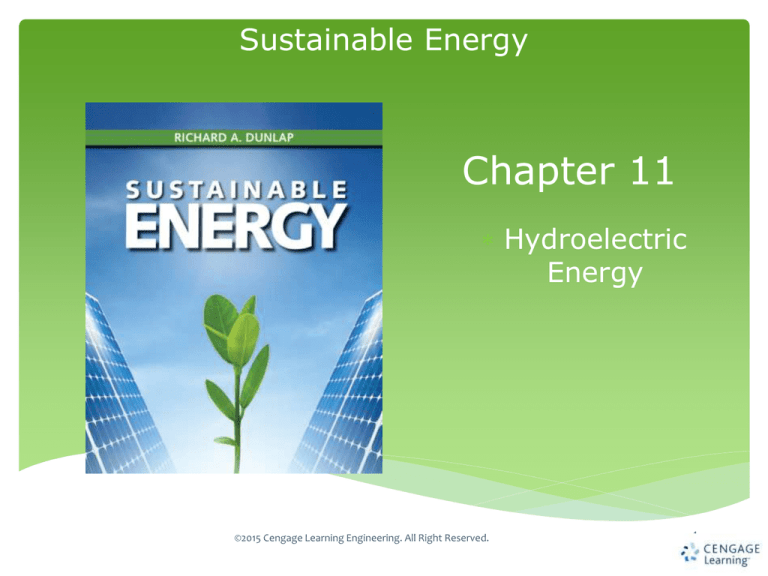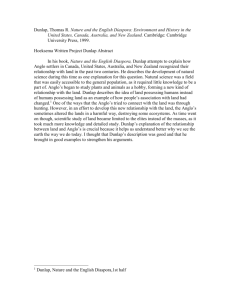
Sustainable Energy
Chapter 11
Hydroelectric
Energy
©2015 Cengage Learning Engineering. All Right Reserved.
1
Sustainable Energy
Dunlap
Learning Objectives
●
●
●
●
●
●
●
The potential energy associated with water.
The kinetic energy associated with water.
The different types of water turbines and their
applications.
The design and properties of high head hydroelectric
systems.
The design and properties of low head and run of the
hydroelectric systems.
The availability and utilization of hydroelectric energy
worldwide.
The effects of hydroelectric energy on the
environment and risks to society.
©2015 Cengage Learning Engineering. All Right Reserved.
2
Sustainable Energy
Dunlap
Energy from water
The energy associated with water running downhill
can be harnessed by turbines in two ways:
(1) potential energy associated with water
confined behind a dam
(2) kinetic energy associated with flowing water
©2015 Cengage Learning Engineering. All Right Reserved.
3
Sustainable Energy
Dunlap
High head systems
High head systems utilize the first approach
head refers to the height of the water above the turbine
©2015 Cengage Learning Engineering. All Right Reserved.
4
Sustainable Energy
Dunlap
Low head and run-of-the-river
systems
Run of the river systems use the second approach
Low head systems are intermediate between these two
©2015 Cengage Learning Engineering. All Right Reserved.
5
Sustainable Energy
Dunlap
Analysis of high head systems
Gravitational potential energy is given as
Power is given as the energy per unit time
This may be written as
where φ is the flow rate in volume of water per unit
time
©2015 Cengage Learning Engineering. All Right Reserved.
6
Sustainable Energy
Dunlap
Analysis of run-of-the-river systems
The kinetic energy associated with a moving mass of water is
The power generated is
or
©2015 Cengage Learning Engineering. All Right Reserved.
7
Sustainable Energy
Dunlap
Turbine design
There are several different turbine designs in
common use which are distinguished by the
geometry of the runner (rotating hub and
blades).
©2015 Cengage Learning Engineering. All Right Reserved.
8
Sustainable Energy
Dunlap
Kaplan turbine runner
©2015 Cengage Learning Engineering. All Right Reserved.
9
Sustainable Energy
Dunlap
Francis turbine runner
©2015 Cengage Learning Engineering. All Right Reserved.
10
Sustainable Energy
Dunlap
Pelton runner
©2015 Cengage Learning Engineering. All Right Reserved.
11
Sustainable Energy
Dunlap
Turgo runner
©2015 Cengage Learning Engineering. All Right Reserved.
12
Sustainable Energy
Dunlap
Different turbine designs are appropriate for
different heads and flow rates
©2015 Cengage Learning Engineering. All Right Reserved.
13
Sustainable Energy
Dunlap
Typical turbine applications
Francis turbines are the most commonly used
design for high head systems (general vertical
axis geometry).
Kaplan turbines are the most commonly used
design for low head systems (vertical or
horizontal axis geometry).
©2015 Cengage Learning Engineering. All Right Reserved.
14
Sustainable Energy
Dunlap
Design of a high head system
Water impounded behind a dam to create a head
generator facility to the left and spillway to the right in the
photograph
©2015 Cengage Learning Engineering. All Right Reserved.
15
Sustainable Energy
Dunlap
Cross sectional view of high head facility using vertical
axis Francis turbine
penstock used to carry water from source (reservoir) to turbine
©2015 Cengage Learning Engineering. All Right Reserved.
16
Sustainable Energy
Dunlap
Design of low head and run of the river
systems
generator facility to right, spillway to left
©2015 Cengage Learning Engineering. All Right Reserved.
17
Sustainable Energy
Dunlap
Cross sectional view of low head system
using horizontal axis Kaplan turbine
©2015 Cengage Learning Engineering. All Right Reserved.
18
Sustainable Energy
Dunlap
Cross sectional view of low head system
using vertical axis Kaplan turbine
©2015 Cengage Learning Engineering. All Right Reserved.
19
Sustainable Energy
Dunlap
Penstock can be used to carry
water to generator facility
©2015 Cengage Learning Engineering. All Right Reserved.
20
Sustainable Energy
Dunlap
World use of hydroelectric power
©2015 Cengage Learning Engineering. All Right Reserved.
21
Sustainable Energy
Dunlap
Importance of hydroelectric power
about 16% or world's electricity
6% of total world energy
major component of electricity for some countries
e.g. Canada 61%
Norway 98%
less important in the United States
©2015 Cengage Learning Engineering. All Right Reserved.
22
Sustainable Energy
Dunlap
Growth of hydroelectric power in
recent years
Relatively little growth in Europe and North America
Substantial growth in South America and Asia (particularly
China)
©2015 Cengage Learning Engineering. All Right Reserved.
23
Sustainable Energy
Dunlap
No actual growth in U.S. in 40 years
©2015 Cengage Learning Engineering. All Right Reserved.
24
Sustainable Energy
Dunlap
Potential for growth in the U.S.
©2015 Cengage Learning Engineering. All Right Reserved.
25
Sustainable Energy
Dunlap
Potential for growth worldwide
Growth potential greatest in Asia
©2015 Cengage Learning Engineering. All Right Reserved.
26
Sustainable Energy
Dunlap
Environmental consequences of
hydroelectric power (high head)
deforestation (loss of carbon sequestering trees)
methane production from dead trees
loss of wildlife habitat
adverse effects on fish migrations
loss of agricultural land
adverse effects on transport of fertile material
downstream for agriculture
• social impact
• potential for dam failure
•
•
•
•
•
•
consequences less significant for low head and
run-of-the-river facilities
©2015 Cengage Learning Engineering. All Right Reserved.
27
Sustainable Energy
Dunlap
Teton Dam failure 1976
©2015 Cengage Learning Engineering. All Right Reserved.
28
Sustainable Energy
Dunlap
Summary
• Potential energy of water in a reservoir can be used to
generate electricity (high head systems)
• Kinetic energy of water flowing in a river can be used (runof-the-river systems)
• Different designs of turbines are suitable for different
applications depending on head and flow rate
• Francis turbines are most suitable for high head applications
• Kaplan turbines are most suitable for low head and run-ofthe-river applications
• Hydroelectric power accounts for about 16% of the world's
electricity production
• Some increase in capacity (particularly in Asia) is possible
• Environmental consequences of hydroelectric power
(particularly high head facilities) need to be considered
carefully
©2015 Cengage Learning Engineering. All Right Reserved.
29



